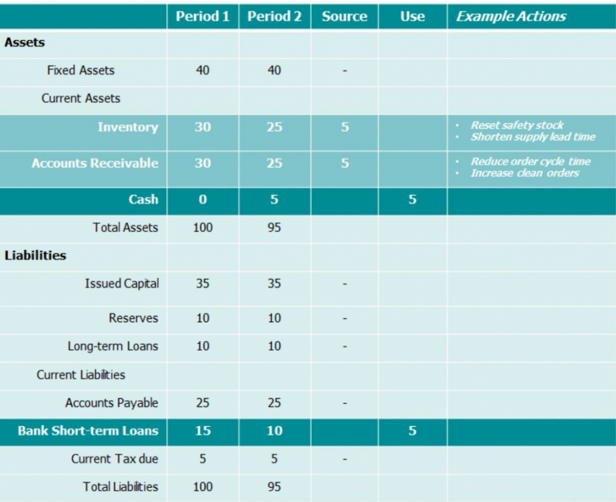By Calum Lewis, below, Founder of OP2MA
 With the economic impact of Covid, Brexit and now the war in Ukraine, many businesses have been left scrambling for cash. With a renewed focus on capital employed, how the supply chain is managed is critical for all businesses that want to survive and grow. How does your business source and use capital? How does the design and management of the supply chain impact on capital requirements? Answers to these questions are imperative, and even apparently small operational improvements can make a significant impact, as this simple illustration demonstrates:
With the economic impact of Covid, Brexit and now the war in Ukraine, many businesses have been left scrambling for cash. With a renewed focus on capital employed, how the supply chain is managed is critical for all businesses that want to survive and grow. How does your business source and use capital? How does the design and management of the supply chain impact on capital requirements? Answers to these questions are imperative, and even apparently small operational improvements can make a significant impact, as this simple illustration demonstrates:

Inventory and Accounts Receivable improvements from ‘period 1’ to ‘period 2’ act as a source of capital to be re-deployed to increase the cash reserve and reduce debt.
Inventory
Inventory is essentially a buffer between demand and supply. It can be, fundamentally, a bet on what your customers will order and when. The odds of this paying off are improved by any information that may be available about possible demand and a rigorous planning process that aligns forecasts and expectations across the business.
Forecasts are, by their very nature wrong, and safety stocks must be held to account for this and to maintain service to customers. Any steps that reduce reliance on forecasts provides a route to reducing inventories.
Inventory can be held in several forms: finished product ready for sale, sub-assemblies requiring final configuration or components requiring processing to end state and assembly. The concept of ‘postponement’ – gearing the supply chain to prepare finished items when customer orders are known and thus reducing or eliminating the need to estimate or forecast demand for finished products – has been applied in many sectors. It relies on an understanding of the best location for the ‘decoupling point’ – the point at which it makes most operational and financial sense to place buffer inventory. It is at this point that forecasts are needed to decide on inventory levels.
Setting desirable inventory levels should be a structured, dynamic exercise and be based on critical analysis of available data and information. It requires a balancing of analysis and judgement. The core parameters should be set with buy-in and commitment from both commercial and operational leaders in the business and need to adapt with the needs of the business and market conditions.
This also means that key performance indicators and incentives should be set such that they support good planning and accountability to the operating parameters of the supply chain. It is no good having production managers continually working to reduce inventory whilst sales managers aim to hit demand targets that inventories cannot fulfil on time.
Accounts Receivable
With every delivery comes a risk; were the products delivered what the customer expected? Did the quantities match those ordered? Were all items intact and labelled correctly? Was the delivery documentation accurate? Was the price on the invoice the price agreed with the customer?
Discrepancies cause delays: the effectiveness of distribution operations is fundamental to securing payment, and crucially, payment on agreed terms. This is not just about the physical delivery, it is also imperative that information about deliveries – including confirmed receipts from customers – is captured on a timely basis and that any apparent discrepancy or claim is resolved promptly to enable payments to be secured. The use of technology is important in supporting seamless data capture, but co-ordination of logistics and finance operations can make a significant difference to the level of outstanding account receivables due.
Accounts Payable
Extending supplier payment terms is often a knee-jerk response to cash flow improvement. Great caution needs to be exercised; collaboration and synchronisation are often untapped opportunities to dramatically reduce costs and working capital requirements. Supply chain resilience can also be significantly undermined by blinkered actions. A review of supplier performance, supply risk and the importance of the supplier to the business should be used to balance payment terms negotiations.
Summary
Assessing trends in the cash-to-cash cycle can indicate issues in supply chain operations. An in-depth review by channel, customer and supplier will bring the transparency needed to target improvements. No aspect of a supply chain operation acts in isolation. For example, inventory level affects the amount of storage space required and handling costs. The quality of customer relationships also has an impact on the information flow in the supply chain. More timely and accurate demand plans require less inventory in the form of safety stock to meet customer requirements.
Supply chain management is fundamentally about managing trade-offs. It is about designing and operating supply chains that balance service, cost, and capital to meet demand in a sustainable way. Capital efficiency can be greatly improved by:
- Managing product and service complexity to ensure it is genuinely value-adding
- Maintaining regular, systematic oversight of inventory processes and parameters to align policies to service expectations
- Taking an end-to-end supply chain perspective on cash flow and driving collaboration with customers and suppliers to swap inventory for information.
Calum Lewis is the founder of OP2MA, an innovative consultancy that focuses on transforming supply chains for sustainable growth


